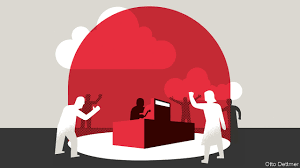A debate about central-bank independence is overdue

THE FEDERAL RESERVE has heard worse. But when the president complains that it has gone “crazy” by tightening monetary policy, as Donald Trump did on October 10th, Americans fret that another norm is about to be overturned. An independent central bank is considered a pillar of a modern economy; presidents are supposed to mutter any criticisms they might have in private. But is that really for the best? Although Mr Trump’s complaints were not intended to start a high-minded debate, one is overdue.
Operational independence for central banks is relatively new. The principle grew out of work in the late 1970s and early 1980s by prominent economists working in the “rational expectations” school of economic thought, among them Finn Kydland and Edward Prescott, who were eventually awarded the Nobel prize. They considered the implications of people’s ability to look into the future and to anticipate the behaviour of self-interested politicians.
Such politicians have much to gain from an unexpected monetary boost. It can temporarily stimulate economic activity. And a burst of inflation reduces the real value of public debt. But a rational citizenry will understand governments’ incentives, anticipate such behaviour and expect higher inflation to follow. Governments will have to pump even more money into the economy to deliver the same boost. Thus, if politicians have discretion over monetary policy, inflation tends to rise inexorably. They might want to leave the printing presses alone, but cannot credibly make a promise to voters to do so.
So, to keep a lid on inflation, it helps to delegate monetary policy to an independent institution. In practice, that has meant packing central-bank boards with hawkish types and letting them do as they will. Soaring prices in the 1970s were tamed when central banks raised interest rates, ignoring the subsequent job losses. Should politicians threaten central-bank autonomy, that hard-won credibility will be lost and inflation will come roaring back.
Or so the story goes. But there are problems with it. One is that central banks’ independence is often overstated. Mr Trump has already appointed a majority of the sitting governors of the Federal Reserve Board. Had he kept his mouth shut but appointed more doveish types, he might have achieved the same end without the outcry. And as Sarah Binder of George Washington University and Mark Spindel, an investment banker, write in their recent book, “The Myth of Independence”, Congress and the Fed are inextricably intertwined. Laws often affect the central bank’s powers (as after the financial crisis, when Congress limited the Fed’s ability to save failing banks). And central banks often weigh in on political questions beyond their narrow remit. Alan Greenspan made perfectly obvious his desire for Bill Clinton to tackle the budget deficit, and spoke in favour of tax cuts during the administration of George W. Bush. The European Central Bank became deeply involved in politics during the euro-zone crisis, in effect making emergency support for struggling governments contingent on the adoption of its preferred policies.
Nor is the relationship between central-bank independence and economic performance as clear-cut as conventional wisdom has it. In Britain in the 1970s, inflation was squeezed out of the economy primarily by the actions of Margaret Thatcher’s government. Some studies turn up a strong link between the two: a notable paper in 1993 by Alberto Alesina and Larry Summers, for instance, found a tight inverse correlation between an index of central-bank independence and average inflation. Yet they also acknowledged, as most of those working on this subject do, that any link between central-bank independence and low inflation could reflect other factors which influence both. Shifting attitudes towards inflation (as a population ages, for example) might nudge governments to pursue anti-inflationary policies, including central-bank independence. Both independence and low inflation would then be a reflection of that underlying shift.
Yet the main reason to revisit independence is the state of the world economy. Inflation has fallen steadily since the early 1980s. Since the early 2000s advanced economies have struggled at least as much with weak growth in prices and wages as with stubborn inflation. Even central banks like the Fed, with a mandate to reduce unemployment as well as inflation, focus on keeping inflation low and stable as the best way to achieve both. Nor is it certain that central banks alone can stabilise economies struggling with chronically low interest rates and inflation. In the aftermath of the financial crisis, interest rates fell to zero yet inflation sagged below central-bank targets for years at a time.
Some economists reckon monetary policy can retain its potency even when rates drop to zero, since if central banks were to promise to allow high inflation in future that would have the effect of reducing the real interest rate (ie, adjusted for inflation) in the present. But central banks cannot credibly make such promises, since forward-looking firms and households will inevitably question whether institutions designed to stifle inflation would embrace it when the time came.
Hard money
Alternative ways to stimulate the economy with rates at zero would require monetary and fiscal authorities to get cosier. Quantitative easing, or printing money to buy assets, exposes the central bank to potential financial losses, and to inevitable political scrutiny. New monetary tools, such as the ability to deliver newly printed money directly to households, would require enabling legislation. Greater reliance on fiscal policy would require central banks and governments to co-ordinate more closely.
Handing control of the printing presses to the president would be unwise. But reforming economic policy to fit a low-rate world requires discussion about the practice of monetary policy. That discussion will necessarily be political. It is not crazy to say so.
This article appeared in the Finance and economics section of the print edition under the headline “Upsetting the punchbowl”




